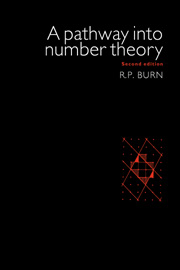Book contents
- Frontmatter
- Contents
- Preface to the second edition
- Introduction
- 1 The fundamental theorem of arithmetic
- 2 Modular addition and Euler's ɸ function
- 3 Modular multiplication
- 4 Quadratic residues
- 5 The equation xn + yn = zn, for n = 2, 3, 4
- 6 Sums of squares
- 7 Partitions
- 8 Quadratic forms
- 9 Geometry of numbers
- 10 Continued fractions
- 11 Approximation of irrationals by rationals
- Bibliography
- Index
- Frontmatter
- Contents
- Preface to the second edition
- Introduction
- 1 The fundamental theorem of arithmetic
- 2 Modular addition and Euler's ɸ function
- 3 Modular multiplication
- 4 Quadratic residues
- 5 The equation xn + yn = zn, for n = 2, 3, 4
- 6 Sums of squares
- 7 Partitions
- 8 Quadratic forms
- 9 Geometry of numbers
- 10 Continued fractions
- 11 Approximation of irrationals by rationals
- Bibliography
- Index
Summary
Ferrers’ graphs
1 1+1+1+1=2+1+1=2+2=3+1+4.
Because of this, the positive integer 4 is said to have five partitions. Exhibit the seven partitions of 5 and the eleven partitions of 6. How many partitions of 7 are there?
2 The five partitions of 4 may be exhibited thus:
and these are called the graphs of the partitions. Exhibit the graphs of the partitions of 5 and of 6.
3 The columns of the graph : • • give the partition 2 + 1 + 1. The rows of the same graph give the partition 3 + 1. Interchanging rows and columns converts : • • to : •. Such pairs of partitions are said to be conjugate. Which partition of 4 is not conjugate to any other partition of 4? Suggest a name for such a partition. Find all the partitions of numbers up to 10 which are not conjugate to any other partition.
4 Exhibit all the partitions of the numbers up to 10 into distinct odd parts.
5 Does every odd number have at least one self-conjugate partition?
6 If a number has a self-conjugate partition, must it have at least one partition into distinct odd parts?
7 If a number has a partition into distinct odd parts, must it have a self-conjugate partition?
8 Conjecture and prove a theorem about the numbers of selfconjugate partitions of a number n and the number of partitions of n into distinct odd parts.
9 Exhibit the partitions of the numbers from 1 to 7 which have only the numbers 1 and/or 2 as parts.
10 How many partitions of 2n are there which have only the numbers 1 and/or 2 as parts?
How many partitions of 2n+1 are there which have only the numbers 1 and/or 2 as parts?
The number of partitions of n in which each part is 1 or 2 is denoted by P2(n).
11 Exhibit the partitions of the numbers from 1 to 7 which have only one or two not necessarily distinct parts.
12 How many partitions of 2n are there which have only one or two not necessarily distinct parts?
What is the number of partitions of 2n+1 which have only one or two not necessarily distinct parts?
- Type
- Chapter
- Information
- A Pathway Into Number Theory , pp. 140 - 153Publisher: Cambridge University PressPrint publication year: 1996

